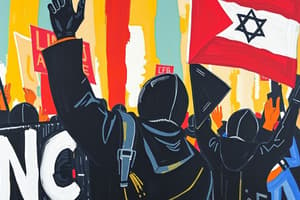Podcast
Questions and Answers
What technological advancement in the 1920s significantly influenced the complexity and reach of protest music?
What technological advancement in the 1920s significantly influenced the complexity and reach of protest music?
- The invention of the electric guitar.
- The introduction of electrical sound recording. (correct)
- The advent of music notation software.
- The development of FM radio broadcasting.
Which of the following describes a primary characteristic of early American protest songs that facilitated their widespread adoption?
Which of the following describes a primary characteristic of early American protest songs that facilitated their widespread adoption?
- Elaborate instrumentation requiring skilled performers.
- Extensive use of metaphors and allegories to engage critical thinking.
- Complex harmonic structures designed to appeal to educated musicians.
- Simple melodies and repetitive lyrics suited for memorization and oral sharing. (correct)
How did the rise of MTV and VH1 in the 1980s affect protest music?
How did the rise of MTV and VH1 in the 1980s affect protest music?
- It had no impact, as protest music remained primarily an underground movement.
- It provided artists with a visual medium to enhance their message and reach a broader audience. (correct)
- It shifted the focus of protest music towards international issues, bypassing local concerns.
- It led to a decline in protest music due to the networks' focus on mainstream genres.
What distinguishes Kendrick Lamar's "Alright" from other protest songs?
What distinguishes Kendrick Lamar's "Alright" from other protest songs?
What was the primary focus of protest songs after the Vietnam War?
What was the primary focus of protest songs after the Vietnam War?
How did social media influence Milck's song "Quiet"?
How did social media influence Milck's song "Quiet"?
Which of the following best represents the role of protest music in social movements?
Which of the following best represents the role of protest music in social movements?
What was the significance of Nina Simone's "Mississippi Goddam"?
What was the significance of Nina Simone's "Mississippi Goddam"?
How did Bob Dylan's approach to being labeled a protest singer differ from Woody Guthrie's?
How did Bob Dylan's approach to being labeled a protest singer differ from Woody Guthrie's?
What is one way protest music of today can stay relevant?
What is one way protest music of today can stay relevant?
Flashcards
Early Protest Song Characteristics
Early Protest Song Characteristics
Early protest songs used simple melodies and repetition for easy memorization and oral sharing.
"Strange Fruit"
"Strange Fruit"
A song by Billie Holiday protesting lynching in the South. Faced near-complete radio ban.
"This Land is Your Land"
"This Land is Your Land"
Woody Guthrie wrote this as a response to "God Bless America", critiquing economic inequality.
"Mississippi Goddam"
"Mississippi Goddam"
Signup and view all the flashcards
"What's Going On"
"What's Going On"
Signup and view all the flashcards
Riot Grrrl
Riot Grrrl
Signup and view all the flashcards
"American Idiot"
"American Idiot"
Signup and view all the flashcards
"Alright"
"Alright"
Signup and view all the flashcards
Milck's "Quiet"
Milck's "Quiet"
Signup and view all the flashcards
Purpose of Protest Music
Purpose of Protest Music
Signup and view all the flashcards
Study Notes
- Early American protest songs featured simple melodies and repetitive lyrics, facilitating memorization and oral transmission.
- Electrical sound recording in the 1920s enabled more complex music, such as Billie Holiday's "Strange Fruit" in 1939, a powerful song addressing lynchings in the South.
- "Strange Fruit" faced a near-complete radio ban, limiting its reach, but not its historical significance.
- After World War II, folk music gained popularity, with Woody Guthrie emerging as a significant protest writer.
- Guthrie wrote "This Land is Your Land" in protest against the song "God Bless America."
- Bob Dylan drew inspiration from Guthrie, though he resisted being labeled a protest movement leader.
- Nina Simone wrote "Mississippi Goddam" in response to the 1963 murder of Medgar Evers and the bombing of the 16th Street Baptist Church.
- The late 1960s and early 1970s experienced political unrest and protest music, including Marvin Gaye’s "What's Going On" in 1971, which addressed issues like the Kent State massacre.
- After the Vietnam War, protest songs shifted to focus on class issues.
- The rise of MTV and VH1 in the 1980s provided artists with a visual medium for expression.
- In the 1980s, hip-hop, including groups like Public Enemy and N.W.A., became a platform for political thought.
- A feminist punk rock movement, Riot Grrrl, emerged in the early to mid-1990s, spearheaded by bands like Bikini Kill and Sleater Kinney.
- Following 9/11, a surge of emotion and frustration led to new music, but a lack of political unity hindered a millennial protest song resurgence.
- Green Day's "American Idiot" in 2004 critiqued the Iraq War.
- Barack Obama's election in 2008 shifted protest music towards empowerment songs.
- Kendrick Lamar's "Alright" became a Black Lives Matter anthem during Obama’s presidency.
- Social media became a critical tool for sharing music.
- Milck's "Quiet," an anthem for the Women’s March, used the internet to recruit a choir.
- The purpose of protest music is to unite a movement.
- Leveraging social media and the internet will help protest music continue.
Studying That Suits You
Use AI to generate personalized quizzes and flashcards to suit your learning preferences.




